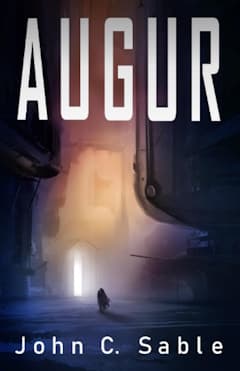
Augur by John C. Sable
(Self-Published, 2022)
Reviewed by Stuart Carter
Monks, eh? What are they like? In Augur, 200 of them seal themselves inside an impenetrable concrete dome for the next 200 years. Or rather, 199 monks do: one runs off en-route to the finished dome (and the concrete dome isn’t completely sealed, as we later discover).
Sealed inside their new home, our monks only see the outside world through “simulations”, but their isolation means they’re now able to predict the future and guide the rest of us towards a better world. How this works is not something that’s explained, and doesn’t feel intuitively very likely, to be honest. Perhaps some Delphic sense kicks in when you’re cut off from the rest of humanity? Or have they discovered psychohistory 10,000 years before Hari Seldon?
Regardless of their method, we eventually learn that only 50 of our brave monks are awake at any one time, with the rest in “stasis”, which goes some way to explaining how the Augur continues to function for two whole centuries. Fortunately, for this story, we only need them to last for one hundred years.
Where are we? And when? Well, we’re not quite in this world. The Augur has been built in “Metro Europa”, where flying cars are common (known as Personal Air Transports—or PATs), and the police are called “Greyjacks”. The first chapter follows Sarnak, a Greyjack captain through whose eyes we see the monks sealed inside the Augur. Sarnak then retires and we say goodbye to him forever, fast-forwarding a hundred years to meet 22-year-old Zyl.
Zyl is angry with and contemptuous of everyone. Like, everyone. So, it’s not really surprising that we meet him in prison. The only people he’s not contemptuous of are the monks sealed in the Augur—he’s only angry with them—and that’s because he’s afraid of them. Zyl hates the Augur and everything it stands for; he wants to see it smashed forever and humanity given back the freedom to do whatever it wants without it being predicted. Or something.
Miraculously, Zyl is released from prison early and called in to see the President of Metro Europa, who has engineered Zyl’s release in order do her a favour. Unfortunately, the favour is to rat on some of Zyl’s anti-Augur friends (grumpy Zyl has friends?) so the President gets elected again. It’s a rotten bargain, but our petulant hero agrees.
Then, via a series of unlikely adventures, Zyl manages to get inside the Augur, but I’d long since ceased to care about Zyl or the Augur, or indeed, Augur, because there are just so many problems with all of them. The unlikeable and overwrought Zyl is one, but I began to lose interest even before chapter 1—during the book’s prologue.
I chose to review Augur because the blurb was intriguing: a mysterious, sealed machine going about its hidden purpose, its inside unknown to its outside, and vice versa, manned by self-sacrificing monks who will die at their task of predicting the future to save the world. Perhaps this would be a metaphor for the novel: inside the dome (the novel) you’re utterly blinkered and only ever see what you’re shown, but nevertheless these remarkable sealed, simulated worlds can predict (and change) the world...sometimes.
Or might it be a Philip K. Dick-style examination of predestination and the ultimate surveillance state (“If you’ve got nothing to hide you’ve got nothing to fear”)? The Augur monks are blind and deaf inside their concrete dome, but are they really unaware of what they’re doing to the world?
Sadly, Augur is none of these, and to be honest, I’m not sure what it’s supposed to be. Some fascinating questions about free will are buried in here somewhere, but they’re smothered by the metaphorical impenetrable concrete dome at the heart of this story, which, sadly, reveals nothing.
Review from BSFA Review 21 - Download your copy here.
